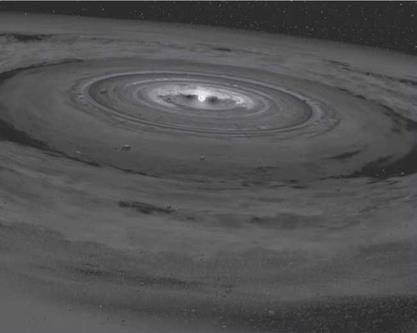Forming New Solar Systems
The cold and dusty nebulae in which stars form are also places where planets form, and Spitzer has helped to tell this story. Newborn stars are embedded in a circumstellar disk of dust and grit coalescing around the star as a result of angular momentum conservation in the collapsing debris cloud. Just as an ice skater spins faster as they bring their arms to their chest, a diffuse cloud with slight rotation shrinks to a rapidly spinning compact disk.47 Protoplanetary disks, like those in the Orion Nebula, are heated by a central star, reradiating all that energy in the infrared. Gas giant planets like Jupiter or Saturn form within the disk in as little as a few million years, the blink of a cosmic eye. The disk then dissipates and leaves behind a sparse gruel of debris made of dust particles that have been recycled though collisions of larger chunks of rock and evaporation (figure 9.4). Spitzer is perfectly suited to studying debris disks because the cool material easily outshines the star in infrared radiation. By comparing disks at various stages of their development, the evolutionary history of how solar systems are born can be pieced together.48
Spitzer’s data indicates that the extremely dense, early phase of disk evolution lasts a couple of million years.49 The process begins as microscopic particles aggregate into larger particles the size of dust grains. Rocky planets like Earth and Mars form by accre-
|
Figure 9.4. An artist’s concept of a young star in its dense disk of gas and dust. Light cannot escape from the interior of the disk, but infrared radiation emerges unaltered and reveals the process of planet formation. Within the disk, theory predicts that matter can accrete from dust grains into several thousand Moon – mass objects in just a few million years (NASA/JPL-Caltech). |
tion, as grit grows into boulders, then mountains, then planets—a process that takes 10 million years. Spectra show that the dust is mixed with gaseous organic molecules, including water (steam), carbon monoxide, carbon dioxide, and methane. Soot or pure carbon grains are an important ingredient of planets, and carbon – based life-f orms. So it was with great excitement that astronomers announced the discovery, a few years ago, of Buckminster fullerenes, or buckyballs, in deep space. Buckyballs are spherical molecules made of sixty carbon atoms arranged in hexagons and pentagons like the panels of a soccer ball; the name alludes to Buckminster Fuller, who designed geodesic domes that look like these carbon molecules. Observations made with Spitzer have shown that buckyballs, or buckminsterfullerenes, are common in hydrogen-rich regions of space such as gaseous nebula where stars are born.50 Buckyballs are surprisingly robust and may be linked to the emergence of life by forming stable cages for concentrating other molecules and so accelerating interaction rates and chemical complexity (plate 16).
Spitzer is well-suited to diagnose the chemistry of planet formation because molecules have most of their spectral transitions at infrared wavelengths. The spectra of dozens of planet-forming disks have revealed interesting anomalies. Hydrogen cyanide (HCN), which is a major repository of interstellar nitrogen, is rarer around stars less than half the Sun’s mass than around solar-type stars. This implies that planets around low-mass stars are nitrogen-poor. Since nitrogen is a key biological ingredient, this implies that life might be rare, or fundamentally different, on planets of low-mass stars. Spitzer has also shown that rocky silicate material in the space between stars is amorphous in form, while silicates in the debris disks associated with planet formation have the sharper spectral features associated with crystalline silicates.51 In the lab, amorphous silicates can only be converted into the crystalline forms by annealing at a temperature of 1000 K, which allows the molecules to gently reorient themselves. In proto-planetary disks, annealing requires recurrent flaring of the star during the first million years of disk evolution. In these cool regions that can only be observed with an infrared telescope, we can observe the early steps along the path to planets and life.











